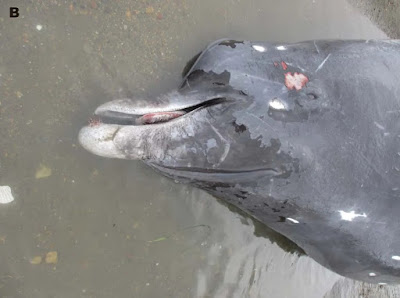![]() |
(A) Trimerodytes balteatus (adult female; Guangxi, China); (B) T. balteatus, showing coloration before shedding; C) T. percarinatus (adult male; K Bang, Gia Lai, Vietnam); (D) T. annularis (subadult male; Guangxi, China); (E) T. aequifasciatus (adult female; Bac Giang, Vietnam; (F) T. yunnanensis (adult male; Dien Bien, Vietnam).
Photographs A, B, C, D by Jinlong Ren; E and F from Le et al. (2015), respectively.
in Ren, Wang, Guo, et al., 2019. |
Abstract
The single prefrontal configuration has historically been used as an important diagnostic character for many natricine taxa. For example, the genus Trimerodytes Cope, 1895 was long been regarded as a junior synonym of Opisthotropis Günther, 1872 for their similar prefrontal configurations and the type species, T. balteatus Cope, 1895, has been assigned to the genus Opisthotropis. However, as the number and arrangement of prefrontal vary frequently both at species and generic level, it is questionable whether the synonymization of Trimerodytes reflects their evolutionary relationships. On the basis of recently collected specimens of O. balteata, the generic status of the species was assessed using both molecular and morphological data. Opisthotropis was recovered as polyphyletic with reference to O. balteata, because O. balteata is nested within the genus Sinonatrix Rossman and Eberle, 1977 and is the sister species of the type species of Sinonatrix. Consequently, we herein resurrect the long-overlooked synonym Trimerodytes from Opisthotropis and synonymize the junior generic nomen Sinonatrix with Trimerodytes. In addition, based on morphological similarities between the monotypic genus Paratapinophis Angel, 1929 and Trimerodytes, we doubt about the validity of Paratapinophis. Following taxonomic changes in this work, the taxonomic account of the genus Trimerodytes, updated descriptions of its type species, and diagnostic key to Trimerodytes species are provided.
Keywords: Paratapinophis, prefrontal scales, Sinonatrix, taxonomic revision, Trimerodytes
![]() |
Figure 5: General view comparisons of Trimerodytes species in life, showing diagnostic character of annulated color patterns of this genus.
(A) T. balteatus (CIB 109017; adult female; Guangxi, China); (B) T. balteatus (CIB 109017), showing coloration before shedding; (C) T. percarinatus (adult male; K Bang, Gia Lai, Vietnam); (D) T. annularis (CIB 109020; subadult male; Guangxi, China); (E) T. aequifasciatus (IEBR 3630; adult female; Bac Giang, Vietnam; from Le et al., 2015); (F) T. yunnanensis (IEBR A.2015.12; adult male; Dien Bien, Vietnam; from Le et al., 2015).
Photographs A, B, C, D by Jinlong Ren; E and F from Le et al. (2015), respectively. |
Trimerodytes Cope, 1895
Liparophis M. G. Peracca, 1904, Rev. Suisse Zool., Geneva, 12: 664.
Type species: Liparophis bedoti M. G. Peracca, 1904.
Sinonatrix D. A. Rossman and W. G. Eberle, 1977, Herpetologica, Lawrence, 33: 42.
Type species: Tropidonotus annularis E. Hallowell, 1857.
Type species: Trimerodytes balteatus Cope, 1895
Etymology: The generic nomen of Trimerodytes is a noun made of three parts: (1) the Ancient Greek τρία “tría”, meaning “three”; (2) the Ancient Greek μέρος “méros”, meaning part, component, or region; and (3) the Greek “dytēs”, meaning diver or swimmer. The generic nomen refers to the three-parted (black-yellow-black) annulated markings and the aquatic life of the type species T.balteatus (Figures 3D, 4, 5A–B). The gender of this generic name is masculine. We suggest “Annulate Keelback” as its English common name, and Huan You She Shu ( 环游蛇属 ) as its Chinese common name.
Content: Five species are currently included (listed below in order of: scientific name; English common name; and Chinese common name):
Trimerodytes aequifasciatus (Barbour, 1908) comb. nov.; Asiatic Annulate Keelback;
“Huan Wen Hua You She” ( 环纹华游蛇 )
Trimerodytes annularis (Hallowell, 1856) comb. nov.; Red-bellied Annulate Keelback;
“Chi Lian Hua You She” ( 赤链华游蛇 )
Trimerodytes balteatus Cope, 1895; Banded Annulate Keelback;
“Heng Wen Huan You She” ( 横纹环游蛇 )
Trimerodytes percarinatus (Boulenger, 1899)
comb. nov.; Olive Annulate Keelback;
“Wu Hua You She” ( 乌 华游蛇 )
Trimerodytes yunnanensis (Rao and Yang, 1998) comb. nov.; Yunnan Annulate Keelback;
“Yun Nan Hua You She” ( 云南华游蛇 )
งูลายสอจีนลายวงแหวน, งูลายสอยูนนาน
Distribution: Members of the genus distribute across southern and eastern China (including Taiwan and Hainan) and northern Southeast Asia (Vietnam, Laos, Thailand, Myanmar, and northeast India).
Jinlong Ren, Kai Wang, Peng Guo, Yingyong Wang, Tao Thien Nguyen and Jiatang Li. 2019. On the Generic Taxonomy of
Opisthotropis balteata (Cope, 1895) (Squamata: Colubridae: Natricinae): Taxonomic Revision of Two Natricine Genera.
Asian Herpetological Research. 10(2); 69–78. DOI:
10.16373/j.cnki.ahr.180091
























































































